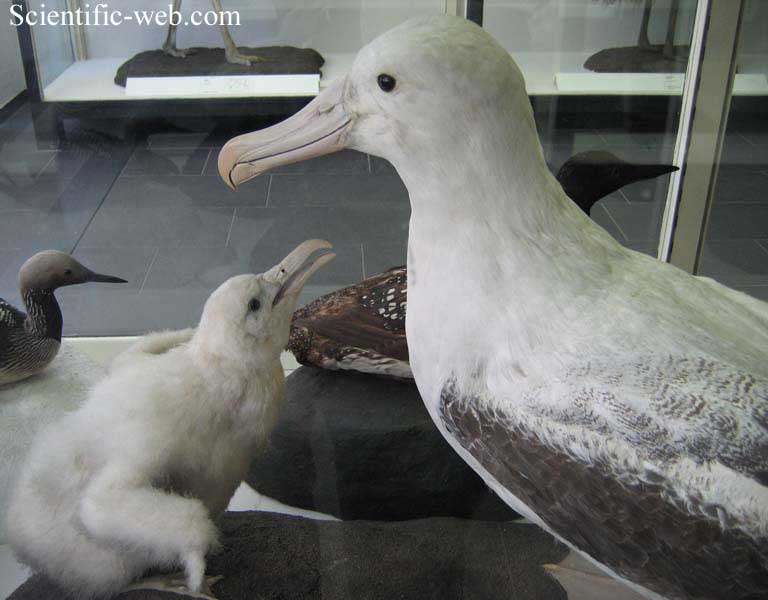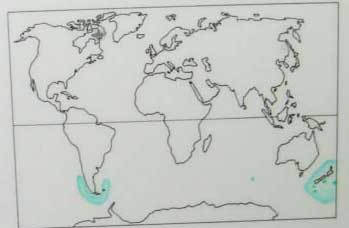
Diomedea epomophora, Photo: Michael Lahanas
Superregnum: Eukaryota
Cladus: Unikonta
Cladus: Opisthokonta
Cladus: Holozoa
Regnum: Animalia
Subregnum: Eumetazoa
Cladus: Bilateria
Cladus: Nephrozoa
Superphylum: Deuterostomia
Phylum: Chordata
Subphylum: Vertebrata
Infraphylum: Gnathostomata
Megaclassis: Osteichthyes
Cladus: Sarcopterygii
Cladus: Rhipidistia
Cladus: Tetrapodomorpha
Cladus: Eotetrapodiformes
Cladus: Elpistostegalia
Superclassis: Tetrapoda
Cladus: Reptiliomorpha
Cladus: Amniota
Classis: Reptilia
Cladus: Eureptilia
Cladus: Romeriida
Subclassis: Diapsida
Cladus: Sauria
Infraclassis: Archosauromorpha
Cladus: Crurotarsi
Divisio: Archosauria
Cladus: Avemetatarsalia
Cladus: Ornithodira
Subtaxon: Dinosauromorpha
Cladus: Dinosauriformes
Cladus: Dracohors
Cladus: Dinosauria
Ordo: Saurischia
Cladus: Eusaurischia
Subordo: Theropoda
Cladus: Neotheropoda
Cladus: Averostra
Cladus: Tetanurae
Cladus: Avetheropoda
Cladus: Coelurosauria
Cladus: Tyrannoraptora
Cladus: Maniraptoromorpha
Cladus: Maniraptoriformes
Cladus: Maniraptora
Cladus: Pennaraptora
Cladus: Paraves
Cladus: Eumaniraptora
Cladus: Avialae
Infraclassis: Aves
Cladus: Euavialae
Cladus: Avebrevicauda
Cladus: Pygostylia
Cladus: Ornithothoraces
Cladus: Ornithuromorpha
Cladus: Carinatae
Parvclassis: Neornithes
Cohors: Neognathae
Cladus: Neoaves
Cladus: Aequornithes
Ordo: Procellariiformes
Familia: Diomedeidae
Genus: Diomedea
Species: Diomedea epomophora
Name
Diomedea epomophora Lesson, 1825

References
Annales Des Sciences Naturelles 6: p. 95
IUCN: Diomedea epomophora (Vulnerable)
Vernacular names
Afrikaans: Witvlerkkoningalbatros
беларуская (тарашкевіца): Паўднёвы каралеўскі альбатрос
беларуская: Паўднёвы каралеўскі альбатрос
български: Кралски албатрос
brezhoneg: Albatroz roueel
català: Albatros reial
Cebuano: Diomedea epomophora
Deutsch: Königsalbatros
English: Southern Royal Albatross
Esperanto: Sudreĝa albatroso
español: Albatros Real
فارسی: آلباتروس سلطنتی جنوبی
suomi: Kuningasalbatrossi
français: Albatros royal
עברית: אלבטרוס מלכותי
magyar: Királyalbatrosz
Bahasa Indonesia: Albatros raja-selatan
日本語: シロアホウドリ
Māori: Toroa ingoingo
Nederlands: Zuidelijke koningsalbatros
norsk nynorsk: Kongealbatross
polski: Albatros królewski
پنجابی: راج البٹراس
português: Albatroz-real-meridional
русский: Королевский альбатрос
svenska: Sydlig kungsalbatross
Türkçe: Kral albatros
українська: Південний королівський альбатрос
Tiếng Việt: Diomedea epomophora
Winaray: Diomedea epomophora
中文: 南方皇家信天翁
The southern royal albatross (Diomedea epomophora) is a large seabird from the albatross family. At an average wingspan of above 3 m (9.8 ft), it is one of the two largest species of albatross, together with the wandering albatross. Recent studies indicate that the southern royal albatross may, on average, be somewhat larger than the wandering albatross in mass and have a similar wingspan,[3] although other sources indicate roughly similar size for the two species and the wandering species may have a larger average (and maximum) wingspan in some colonies.[4]
Taxonomy
In flight
Albatrosses belong to family Diomedeidae of the order Procellariiformes, along with shearwaters, fulmars, storm petrels, and diving petrels. They share certain identifying features. First, they have nasal passages that attach to the upper bill called naricorns; the nostrils of the albatross are on the sides of the bill. The bills of Procellariiformes are also unique in that they are split into between seven and nine horny plates. Finally, they produce a stomach oil made up of wax esters and triglycerides that is stored in the proventriculus. This is used against predators as well as an energy rich food source for chicks and for the adults during their long flights.[5]
This species was once considered conspecific with the northern royal albatross (Diomedea sanfordi) as the royal albatross. The split into two species is widely though not universally accepted: it is recognized by, for example by, BirdLife International,[6] Brooke,[7] and Robertson & Nunn,[8] but not by Clements,[9] while the American Ornithologists' Union has recognized the need for a proposal.[10]
Etymology
In flight
In flight
Diomedea refers to Diomedes, a figure from Greek mythology whose companions turned to birds.[11]
Description
The southern royal albatross has a length of 112 to 123 cm (44–48 in)[12] and a mean weight of 8.5 kg (19 lb). At Campbell Island, 11 males were found to have a mean mass of 10.3 kg (23 lb) and 7 females were found to have a mean mass of 7.7 kg (17 lb), thus may be heavier on average than most colonies of wandering albatross.[4] Males are about 2 to 3 kg (4.4 to 6.6 lb) heavier than females. Average wingspan has been reported from 2.9 to 3.28 m (9.5 to 10.8 ft), with an upper limit of about 3.51 m (11.5 ft). The wandering albatross can exceed this species in maximum size and averages slightly larger in linear dimensions if not bulk, but the two species are close enough in dimensions that size cannot be used to distinguish between them.[13][14][15] The juvenile has a white head, neck, upper mantle, rump, and underparts. There are black speckles on the mantle, and dark brown or black wings with white flecks on coverts. The tail is white except for the black tip as is the under-wing. Young birds soon lose the black on their tail and backs. White appears on the upperwing gradually, as speckles starting from the leading edge. All ages have a pink bill with black on the cutting edge on the upper mandible, and the legs are flesh-coloured. Young birds with all-dark upperwings can be hard to differentiate from the northern royal albatross. There are clear but subtle differences from the wandering albatross, with the southern royal having a clean black and white appearance, lacking the peach neck spot often found on the wandering albatross. Most wandering albatrosses have dark feathers in the tail and crown and the white in this species expands from the middle of the wing, in larger blotches. The bill color is also slightly paler, as well as the dark cutting edge along the middle. The average life span is 58 years.[16]
Range
Breeding Population and Trends[12] Location Population Date Trend
Campbell Islands 8,200-8,600 pair 1997 Stable
Enderby Island 69 pair 2001 Stable
Auckland Island & Adams Island 20 pair 2001 Stable
Total 28,000-29,500 1997 Stable
Most of the royal albatross population is found between 30° S and 45° S.[17] The majority of the world's population of southern royal albatrosses nest on the rat-free[18] subantarctic Campbell Island, around 8,200 to 8,600 pairs. There are smaller colonies on Adams Island and Auckland Island in the Auckland Islands, 20 pairs combined, and 69 pairs on Enderby Island and some sanfordi × epomophora hybrids at the northern royal albatross colony on the Otago Peninsula in New Zealand. They range along the southern oceans concentrating on the west and east coast of southern South America, and also in the waters surrounding New Zealand.[12]
Behavior
They attract their mates using methods such as bill-snapping, clapping and gulping. Others ways also include sky-calling with outstretched wings, and neck and head stretched upwards.[19]
Feeding
The southern royal albatross eats squid and fish, with smaller amounts of carrion, crustaceans, and salps.[12] Its foraging activities normally take place within a 1250 km radius of the breeding site.[20] Although they travel vast distances, royal albatrosses in general tend to forage in somewhat shallower waters and closer to continental shelves than wandering albatrosses.[21]
Reproduction
Southern Royal Albatrosses beaking - SE Tasmania.jpg
They prefer to nest on tussock grassland, plateaus, or ridges, and will lay one egg biennially. This will normally take place in November or December. Both parents will incubate the egg, and rear the young. After they are born it takes about 240 days for a baby to grow its wings fully and fly by itself.There is very low mortality rates of the laid eggs once the parents settle in.[22] When feeding the young they will range south to the Campbell Plateau and north to the Chatham Rise.[12]
Conservation
The IUCN classifies this bird as vulnerable,[1] with an occurrence range of 63,400,000 km2 (24,500,000 sq mi) and a breeding range of 750 km2 (290 sq mi), with a total estimated population of between 28,000 and 29,500 (1997). As a top-tier organism in its natural habitat, it has very few predators but major fishing industries are a huge problem for all albatross species among other seabirds.[23]
The population is recovering from its severe downward spiral in the late 19th and early 20th centuries. By the 1880s, this albatross was extirpated from Auckland Island and Enderby Island. Pigs and cats are still a problem, as they take chicks and eggs, on Auckland Island. Longline fishing is a major problem and a possible emerging threat is Dracophyllum, a scrub that is taking away from their nesting range.[12]
Footnotes
BirdLife International (2018). "Diomedea epomophora". IUCN Red List of Threatened Species. 2018: e.T22698314A132641187. doi:10.2305/IUCN.UK.2018-2.RLTS.T22698314A132641187.en. Retrieved 12 November 2021.
Checklist of the birds of New Zealand, Norfolk and Macquarie Islands, and the Ross Dependency, Antarctica (4th ed.). Wellington, N.Z.: Te Papa Press in association with the Ornithological Society of New Zealand. 2010. p. 67. ISBN 978-1-877385-59-9.
Albatross, their world, their ways. De Roy, Jones and Fitter, 2008. Firefly Press
CRC Handbook of Avian Body Masses, 2nd Edition by John B. Dunning Jr. (Editor). CRC Press (2008), ISBN 978-1-4200-6444-5.
Double, M. C. (2003)
Lee, James (2008)
Brooke, R. (2004)
Robertson, C. J. R. & Nunn, G. B. (1998)
Clements, J. (2007)
Remsen Jr., C. J. (2008)
Gotch, A. F. (1995)
BirdLife International (2008)
Brooke, Michael, Albatrosses and Petrels across the World. Oxford University Press (2004), ISBN 978-0-19-850125-1
Wood, Gerald (1983). The Guinness Book of Animal Facts and Feats. ISBN 978-0-85112-235-9.
Harrison, Peter, Seabirds: An Identification Guide. Houghton Mifflin Harcourt (1991), ISBN 978-0-395-60291-1
LaGosh, J. (2004). Diomedea epomophora. Retrieved from http://animaldiversity.ummz.umich.edu/site/accounts/information/Diomedea_epomophora.html
Robertson, C. J. R., & Kinsky, F. C. (1972). The dispersal movements of the royal albatross (Diomedea epomophora). Notornis, 19(4), 289-301.
"Campbell Island conservation sanctuary rat free". The Beehive. Retrieved 2022-05-18.
Moore, Peter (2008)
Waugh, S., Troup, C., Filippi, D., & Weimerskirch, H. (2002). Foraging zones of Southern Royal albatrosses. The Condor, 104(3), 662-667.
Imber (1999). Diet and Feeding Ecology of the Royal Albatross Diomedea epomophora - King of the Shelf Break and Inner Slope. Emu 99(3) 200 - 211
Dilks, P. J., & Wilson, P. R. (1979). Feral sheep and cattle and royal albatrosses on Campbell Island; population trends and habitat changes. New Zealand Journal of Zoology, 6(1), 127-139.
Sullivan, B. J., Reid, T. A., & Bugoni, L. (2006). Seabird mortality on factory trawlers in the Falkland Islands and beyond. Biological Conservation, 131(4), 495–504.
References
BirdLife International (2008). "Bartlett's Tinamou - BirdLife Species Factsheet". Data Zone. Retrieved 18 Feb 2009.
Brands, Sheila (Aug 14, 2008). "Systema Naturae 2000 / Classification - Diomedea (Diomedea) epomophora -". Project: The Taxonomicon. Retrieved 18 Feb 2009.
Brooke, M. (2004). "Procellariidae". Albatrosses And Petrels Across The World. Oxford, UK: Oxford University Press. ISBN 0-19-850125-0.
Clements, James (2007). The Clements Checklist of the Birds of the World (6th ed.). Ithaca, NY: Cornell University Press. ISBN 978-0-8014-4501-9.
Double, M. C. (2003). "Procellariiformes (Tubenosed Seabirds)". In Hutchins, Michael; Jackson, Jerome A.; Bock, Walter J.; Olendorf, Donna (eds.). Grzimek's Animal Life Encyclopedia. Vol. 8 Birds I Tinamous and Ratites to Hoatzins. Joseph E. Trumpey, Chief Scientific Illustrator (2nd ed.). Farmington Hills, MI: Gale Group. pp. 107–111. ISBN 0-7876-5784-0.
Gotch, A. F. (1995) [1979]. "Albatrosses, Fulmars, Shearwaters, and Petrels". Latin Names Explained A Guide to the Scientific Classifications of Reptiles, Birds & Mammals. New York, NY: Facts on File. p. 190. ISBN 0-8160-3377-3.
Lee, James (6 Oct 2008). "Table 7: Species changing IUCN Red List Status" (PDF). IUCN RedList. BirdLife International. Archived from the original (PDF) on March 6, 2009. Retrieved 18 Feb 2009.
Moore, Peter (2008). "Notes on New Zealand Mammals 8. Predation on Nesting Southern Royal Albatrosses Diomedea Epomophora by a New Zealand Sea Lion Phocarctos Hookeri". Data Zone. Retrieved 18 Mar 2022.
Remsen Jr., J. V.; et al. (7 Aug 2008). "A classification of the bird species of South America, South American Classification Committee, American Ornithologists' Union". South American Classification Committee. American Ornithologists' Union. Archived from the original on 2009-03-02. Retrieved 18 Feb 2009.
Robertson, C. J. R.; Nunn, G. B. (1998). "Towards a new taxonomy of albatrosses". Albatross Biology and Conservation. Chipping Norton, Australia: Surrey Beatty & Sons Ltd. pp. 13–19.
Waugh, Susan (2002). "FORAGING ZONES OF SOUTHERN ROYAL ALBATROSSES". Data Zone. Retrieved 18 Mar 2022.
Retrieved from "http://en.wikipedia.org/"
All text is available under the terms of the GNU Free Documentation License

